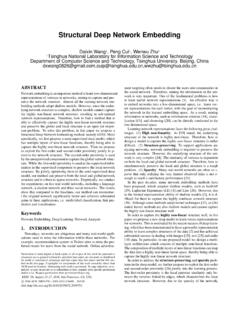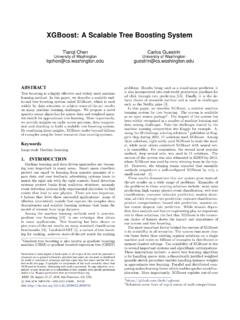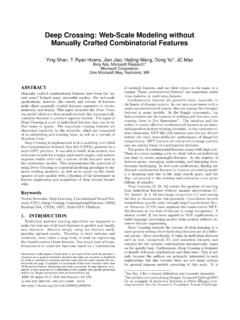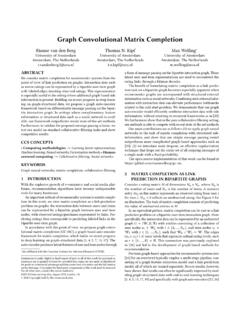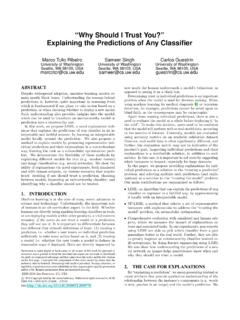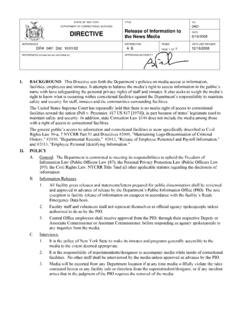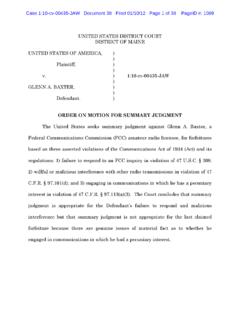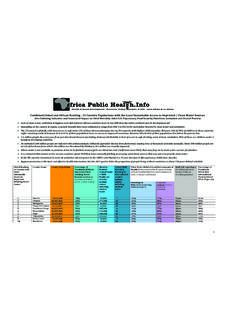Transcription of Fake News Detection on Social Media: A Data …
1 Fake news Detection on Social Media: a data Mining PerspectiveKai Shu , Amy Sliva , Suhang Wang , Jiliang Tang\, and Huan Liu Computer Science & Engineering, Arizona State University, Tempe, AZ, USA Charles River Analytics, Cambridge, MA, USA\Computer Science & Engineering, Michigan State University, East Lansing, MI, USA media for news consumption is a double-edged the one hand, its low cost, easy access, and rapid dissem-ination of information lead people to seek out and consumenews from Social media . On the other hand, it enables thewide spread of fake news , , low quality news with in-tentionally false information. The extensive spread of fakenews has the potential for extremely negative impacts onindividuals and society. Therefore, fake news Detection onsocial media has recently become an emerging research thatis attracting tremendous attention.
2 Fake news detectionon Social media presents unique characteristics and chal-lenges that make existing Detection algorithms from tradi-tional news media ineffective or not applicable. First, fakenews is intentionally written to mislead readers to believefalse information, which makes it difficult and nontrivial todetect based on news content; therefore, we need to includeauxiliary information, such as user Social engagements onsocial media , to help make a determination. Second, ex-ploiting this auxiliary information is challenging in and ofitself as users Social engagements with fake news producedata that is big, incomplete, unstructured, and noisy. Be-cause the issue of fake news Detection on Social media is bothchallenging and relevant, we conducted this survey to fur-ther facilitate research on the problem.
3 In this survey, wepresent a comprehensive review of detecting fake news onsocial media , including fake news characterizations on psy-chology and Social theories, existing algorithms from a datamining perspective, evaluation metrics and representativedatasets. We also discuss related research areas, open prob-lems, and future research directions for fake news detectionon Social INTRODUCTIONAs an increasing amount of our lives is spent interactingonline through Social media platforms, more and more peo-ple tend to seek out and consume news from Social mediarather than traditional news organizations. The reasons forthis change in consumption behaviors are inherent in thenature of these Social media platforms: (i) it is often moretimely and less expensive to consume news on Social mediacompared with traditional news media , such as newspapersor television; and (ii) it is easier to further share, commenton, and discuss the news with friends or other readers onsocial media .
4 For example, 62 percent of adults getnews on Social media in 2016, while in 2012, only 49 per-cent reported seeing news on Social media1. It was alsofound that Social media now outperforms television as themajor news source2. Despite the advantages provided bysocial media , the quality of news on Social media is lowerthan traditional news organizations. However, because itis cheap to provide news online and much faster and easierto disseminate through Social media , large volumes of fakenews, , those news articles with intentionally false infor-mation, are produced online for a variety of purposes, suchas financial and political gain. It was estimated that over 1million tweets are related to fake news Pizzagate 3by theend of the presidential election. Given the prevalence of thisnew phenomenon, Fake news was even named the word ofthe year by the Macquarie dictionary in extensive spread of fake news can have a serious nega-tive impact on individuals and society.
5 First, fake news canbreak the authenticity balance of the news ecosystem. Forexample, it is evident that the most popular fake news waseven more widely spread on Facebook than the most pop-ular authentic mainstream news during the 2016 pres-ident election4. Second, fake news intentionally persuadesconsumers to accept biased or false beliefs. Fake news isusually manipulated by propagandists to convey politicalmessages or influence. For example, some report shows thatRussia has created fake accounts and Social bots to spreadfalse stories5. Third, fake news changes the way people in-terpret and respond to real news . For example, some fakenews was just created to trigger people s distrust and makethem confused, impeding their abilities to differentiate whatis true from what is not6. To help mitigate the negative ef-fects caused by fake news both to benefit the public andthe news ecosystem It s critical that we develop methods toautomatically detect fake news on Social #.
6 GjJyKapW5y5 fake news on Social media poses several new andchallenging research problems. Though fake news itself isnot a new problem nations or groups have been using thenews media to execute propaganda or influence operationsfor centuries the rise of web-generated news on Social me-dia makes fake news a more powerful force that challengestraditional journalistic norms. There are several character-istics of this problem that make it uniquely challenging forautomated Detection . First, fake news is intentionally writ-ten to mislead readers, which makes it nontrivial to detectsimply based on news content. The content of fake news israther diverse in terms of topics, styles and media platforms,and fake news attempts to distort truth with diverse lin-guistic styles while simultaneously mocking true news . Forexample, fake news may cite true evidence within the in-correct context to support a non-factual claim [22].
7 Thus,existing hand-crafted and data -specific textual features aregenerally not sufficient for fake news Detection . Other aux-iliary information must also be applied to improve detec-tion, such as knowledge base and user Social , exploiting this auxiliary information actually leadsto another critical challenge: the quality of the data news is usually related to newly emerging, time-criticalevents, which may not have been properly verified by exist-ing knowledge bases due to the lack of corroborating ev-idence or claims. In addition, users Social engagementswith fake news produce data that is big, incomplete, un-structured, and noisy [79]. Effective methods to differenti-ate credible users, extract useful post features and exploitnetwork interactions are an open area of research and needfurther this article, we present an overview of fake news detectionand discuss promising research directions.
8 The key motiva-tions of this survey are summarized as follows: Fake news on Social media has been occurring for sev-eral years; however, there is no agreed upon definitionof the term fake news . To better guide the futuredirections of fake news Detection research, appropriateclarifications are necessary. Social media has proved to be a powerful source forfake news dissemination. There are some emergingpatterns that can be utilized for fake news detectionin Social media . A review on existing fake news detec-tion methods under various Social media scenarios canprovide a basic understanding on the state-of-the-artfake news Detection methods. Fake news Detection on Social media is still in the earlyage of development, and there are still many challeng-ing issues that need further investigations. It is neces-sary to discuss potential research directions that canimprove fake news Detection and mitigation facilitate research in fake news Detection on Social me-dia, in this survey we will review two aspects of the fakenews Detection problem:characterizationanddetection.
9 Asshown in Figure 1, we will first describe the background ofthe fake news Detection problem using theories and prop-erties from psychology and Social studies; then we presentthe Detection approaches. Our major contributions of thissurvey are summarized as follows: We discuss the narrow and broad definitions of fakenews that cover most existing definitions in the litera-ture and further present the unique characteristics offake news on Social media and its implications com-pared with the traditional media ; We give an overview of existing fake news detectionmethods with a principled way to group representativemethods into different categories; and We discuss several open issues and provide future di-rections of fake news Detection in Social remainder of this survey is organized as follows.
10 InSection 2, we present the definition of fake news and char-acterize it by comparing different theories and properties inboth traditional and Social media . In Section 3, we continueto formally define the fake news Detection problem and sum-marize the methods to detect fake news . In Section 4, wediscuss the datasets and evaluation metrics used by existingmethods. We briefly introduce areas related to fake news de-tection on Social media in Section 5. Finally, we discuss theopen issues and future directions in Section 6 and concludethis survey in Section FAKE news CHARACTERIZATIONIn this section, we introduce the basic Social and psychologi-cal theories related to fake news and discuss more advancedpatterns introduced by Social media . Specifically, we firstdiscuss various definitions of fake news and differentiate re-lated concepts that are usually misunderstood as fake then describe different aspects of fake news on tradi-tional media and the new patterns found on Social Definitions of Fake NewsFake news has existed for a very long time, nearly the sameamount of time as news began to circulate widely after theprinting press was invented in 14397.

